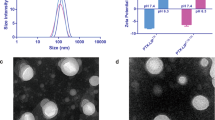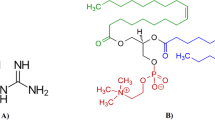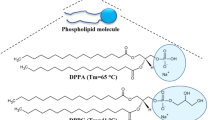Abstract
The biodistribution and pharmacokinetics of 111In-DTPA-labelled pegylated liposomes in tumour-bearing nude mice was studied to examine possible applications of pegylated liposome-targeted anti-cancer therapies. Nude mice received an intravenous injection of 100 μl of 111In-DTPA-labelled pegylated liposomes, containing 0.37–0.74 MBq of activity. The t1/2α and t1/2β of 111In-DTPA-labelled pegylated liposomes were 1.1 and 10.3 h, respectively. Tumour uptake was maximal at 24 h at 5.5 ± 3.0% ID g–1. Significant reticuloendothelial system uptake was demonstrated with 19.3 ± 2.8 and 18.8 ± 4.2% ID g–1 at 24 h in the liver and spleen, respectively. Other sites of appreciable deposition were the kidney, skin, female reproductive tract and to a lesser extent the gastrointestinal tract. There was no indication of cumulative deposition of pegylated liposomes in the lung, central nervous system, musculoskeletal system, heart or adrenal glands. In contrast, the t1/2α and t1/2β of unencapsulated 111In-DTPA were 5 min and 1.1 h, respectively, with no evidence of accumulation in tumour or normal tissues. Incubation of 111In-DTPA-labelled pegylated liposomes in human serum for up to 10 days confirmed that they are very stable, with only minor leakage of their contents. The potential applications of pegylated liposomes in the arena of targeted therapy of solid cancers are discussed. © 2000 Cancer Research Campaign
Similar content being viewed by others
Article PDF
Change history
16 November 2011
This paper was modified 12 months after initial publication to switch to Creative Commons licence terms, as noted at publication
References
Allen TM and Chonn A (1987) Large unilamellar liposomes with low uptake by the reticuloendothelial system. FEBS Lett 223: 42–46
Bangham AD, Standish HM and Watkins JC (1965) Diffusion of univalent ions across the lamellae of swollen phospholipids. J Mol Biol 13: 238–252
Berry G, Billingham M, Alderman E, Torti F, Lum B, Dumond C and Martin F (1996) Reduced cardiotoxicity of DOXIL (pegylated liposomal doxorubicin) in AIDS Kaposi’s sarcoma patients compared to a matched control group of cancer patients given doxorubicin. Proceedings of the American Society of Clinical Oncologists 15: 303(abstract 843)
Britten RA, Evans AJ and Allalunis-Turner MJ (1996) Effect of cisplatin on the clinically-relevant radiosensitivity of human cervical carcinoma cell lines. Int J Radiat Oncol Biol Phys 34: 367–374
Eagle H. Propagation in a fluid medium of a human epidermoid carcinoma Strain KB (1955). Proc Soc Exp Biol Med 89: 362–364
Gabizon AA (1994) Liposomal anthracyclines. Hematol Oncol Clin N America 8: 431–450
Gabizon A and Papahadjopoulos D (1988) Liposome formulations with prolonged circulation time in blood and enhanced uptake in tumours. Proc Natl Acad Sci USA 85: 6949–6953
Gabizon A, Catane R, Uziely B, Kaufman B, Safra T, Cohen R, Martin F, Huang A and Barenholz Y (1994) Prolonged circulation time and enhanced accumulation in malignant exudates of doxorubicin encapsulated in polethylene-glycol coated liposomes. Cancer Res 54: 987–992
Goebel F-D, Goldstein D, Goos M, Jablonowski H and Stewart JS (1996) Efficacy and safety of Stealth liposomal doxorubicin in AIDS-related Kaposi’s sarcoma. Br J Cancer 73: 989–994
Gordon KB, Tajuddin A, Guitart J, Kuzel TM, Eramo LR and Von Roenn J (1995) Hand-foot syndrome associated with liposome-encapsulated doxorubicin therapy. Cancer 75: 2169–2173
Gregoriades G, Swain CP, Wills EJ and Tavill AS (1974) Drug-carrier potential of liposomes in cancer chemotherapy. Lancet 1: 1313–1316
Harrison M, Tomlinson D and Stewart S (1995) Liposomal entrapped doxorubicin: an active agent in AIDS-related Kaposi’s sarcoma. J Clin Oncol 13: 914–920
Huang SK, Lee K-D, Hong K, Friend DS and Papahadjopoulos D (1992) Microscopic localisation of sterically stabilised liposomes in colon carcinoma-bearing mice. Cancer Res 52: 5135–5143
Huang SK, Martin FJ, Jay G, Vogel J, Papahadjopoulos D and Friend DS (1993) Extravasation and transcytosis of liposomes in Kaposi’s sarcoma-like dermal lesions of transgenic mice bearing the HIV tat gene. Am J Pathol 143: 1–14
Lasic DD and Papahadjopoulos D (1995) Liposomes revisited. Science 267: 1275–1276
Madhavan S and Northfelt DW (1995) Lack of vesicant injury following extravasation of liposomal doxorubicin. J Natl Cancer Inst 87: 1556–1557
Maraveyas A, Stafford N, Rowlinson-Busza G, Stewart JSW and Epenetos AA (1995) Pharmacokinetics, biodistribution and dosimetry of specific and control radiolabelled monoclonal antibodies in patients with primary head and neck squamous cell carcinoma. Cancer Res 55: 1060–1069
Martin FJ (1997) Future prospects for Stealth liposomes in cancer therapy. Oncology 11: 63–68
Mayhew EG, Lasic D, Babbar S and Martin FJ (1992) Pharmacokinetics and antitumour activity of epirubicin encapsulated in long-circulating liposomes incorporating a polyethylene glycol-derivatized phospholipid. Int J Cancer 51: 302–309
McGinn CJ and Kinsella TJ (1992) The experimental and clinical rationale for the use of S-Phase-specific radiosensitisers to overcome tumour cell repopulation. Semin Oncol 4: 21–28
Muggia FM, Hainsworth JD, Jeffers S, Miller P, Groshen S, Tan M, Roman L, Uziely B, Muderspach L, Garcia A, Burnett A, Greco FA, Morrow CP, Paradiso L and Liang L-J (1997) Phase II study of liposomal doxorubicin in refractory ovarian cancer: antitumour activity and toxicity modification by liposomal encapsulation. J Clin Oncol 15: 987–993
Newman MS, Colbern GT, Working PK, Engbers C and Amantea MA (2000) Comparative pharmacokinetics, tissue distribution and therapeutic effectiveness of cisplatin encapsulated in long-circulating, pegylated liposomes (SPI-077) in tumour-bearing mice. Cancer Chemother Pharmacol 43: 1–7
Ng TT and Denning DW (1995) Liposomal amphotericin B (AmBisome) therapy in invasive fungal infections. Evaluation of United Kingdom Compassionate use data. Arch Intern Med 155: 1093–1098
Northfelt DW, Dezube B, Thommes JA, Miller BJ, Fischl MA, Friedman-Kien A, Kaplan LD, DuMond C, Mamelok RD and Henry DH (1998) Pegylated-liposomal doxorubicin versus doxorubicin, bleomycin and vincristine in the treatment of AIDS-related Kaposi’s sarcoma: results of a randomised phase III clinical trial. J Clin Oncol 16: 2445–2451
Papahadjopoulos D, Allen TM, Gabizon A, Mayhew E, Matthay K, Huang SK, Lee K-D, Woodle MC, Lasic DD, Redemann C and Martin FJ (1991) Sterically stabilised liposomes: Improvements in pharmacokinetics and anti-tumour therapeutic efficacy. Proc Natl Acad Sci USA 88: 11460–11464
Ranson MR, Carmichael J, O’Byrne K, Stewart S, Smith D and Howell A (1997) Treatment of advanced breast cancer with sterically stabilized liposomal doxorubicin: results of a multicentre phase II trial. J Clin Oncol 15: 3185–3191
Russo R, Nigro LC and Minniti S (1996) Visceral leishmaniasis in HIV infected patients: treatment with high dose liposomal amphotericin B (AmBisome). J Infect 32: 133–137
Saunders M and Dische S (1996) Clinical results of hypoxic cell radiosensitisation from hyperbaric oxygen to accelerated radiotherapy, carbogen and nicotinamide. Br J Cancer 74: S271–S278
Siegal T, Horowitz A and Gabizon A (1995) Doxorubicin encapsulated in sterically stabilised liposomes for the treatment of a brain tumour model: biodistribution and therapeutic efficacy. J Neurosurg 83: 1029–1037
Stewart JSW, Jablonowski H, Goebel F-D, Arasteh K, Spittle M, Rios A, Aboulafia D, Galleshaw J and Dezube BJ (1998) Randomised comparative trial of pegylated liposomal doxorubicin versus bleomycin and vincristine in the treatment of AIDS-related Kaposi’s sarcoma. International Pegylated Liposomal Doxorubicin Study Group. J Clin Oncol 16: 683–691
Vaage J, Barbera-Guillem E, Abra R, Huang A and Working P (1994) Tissue distribution and therapeutic effect of intravenous free or encapsulated liposomal doxorubicin on human prostate carcinoma xenografts. Cancer 73: 1478–1484
Vaage J, Donovan D, Loftus T and Working P (1995) Prevention of metastasis from mouse mammary carcinomas with liposomes carrying doxorubicin. Br J Cancer 72: 1074–1075
Vaage J, Donovan D, Mayhew E, Uster P and Woodle M (1993a) Therapy of mouse mammary carcinomas with vincristine and doxorubicin encapsulated in sterically stabilised liposomes. Int J Cancer 54: 959–964
Vaage J, Mayhew E, Lasic D and Martin F (1992) Therapy of primary and metastatic mouse mammary carcinomas with doxorubicin encapsulated in long circulating liposomes. Int J Cancer 51: 942–948
Vaage J, Donovan D, Mayhew E, Abra R and Huang A 1993b) Therapy of human ovarian carcinoma xenografts using doxorubicin encapsulated in sterically stabilised liposomes. Cancer 72: 3671–3675
Vaage J, Donovan D, Wipff E, Abra R, Colbern G, Uster P and Working P (2000) Therapy of a xenografted human colonic carcinoma using cisplatin or doxorubicin encapsulated in long-circulating pegylated stealth liposomes. Int J Cancer 80: 134–137
Williams SS, Alosco TR, Mayhew E, Lasic DD, Martin FJ and Bankert RB (1993) Arrest of human lung tumour xenograft growth in severe combined immunodeficient mice using doxorubicin encapsulated in sterically stabilised liposomes. Cancer Res 53: 3964–3967
Author information
Authors and Affiliations
Rights and permissions
From twelve months after its original publication, this work is licensed under the Creative Commons Attribution-NonCommercial-Share Alike 3.0 Unported License. To view a copy of this license, visit http://creativecommons.org/licenses/by-nc-sa/3.0/
About this article
Cite this article
Harrington, K., Rowlinson-Busza, G., Syrigos, K. et al. Biodistribution and pharmacokinetics of 111In-DTPA-labelled pegylated liposomes in a human tumour xenograft model: implications for novel targeting strategies. Br J Cancer 83, 232–238 (2000). https://doi.org/10.1054/bjoc.1999.1232
Received:
Revised:
Accepted:
Published:
Issue date:
DOI: https://doi.org/10.1054/bjoc.1999.1232
Keywords
This article is cited by
-
Current hurdles to the translation of nanomedicines from bench to the clinic
Drug Delivery and Translational Research (2022)
-
Targeted radiosensitisation by pegylated liposome-encapsulated 3′, 5′-O-dipalmitoyl 5-iodo-2′-deoxyuridine in a head and neck cancer xenograft model
British Journal of Cancer (2004)
-
Defining the success of cardiac gene therapy: how can nuclear imaging contribute?
European Journal of Nuclear Medicine and Molecular Imaging (2003)



